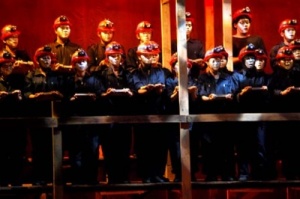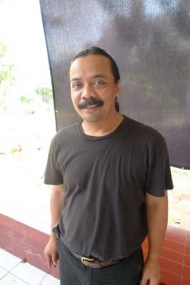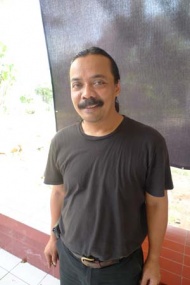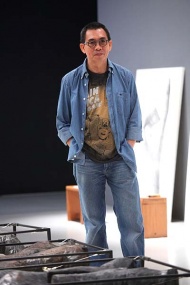‘The Silent Song of Genjer Flowers’: Against despair through storytelling
In her play “Nyanyi Sunyi Kembang-Kembang Genjer” (The Silent Song of Genjer Flowers), feminist playwright Faiza Mardzoeki captures how, for female survivors of the communist purge, the simple act of telling their stories is an act against despair.
What is it like to keep the secret of the most painful experience you’ve ever had from your own flesh and blood? What is it like to be emotionally alienated from your loved ones, separated by lies systematically spread and kept alive for decades?
In modern-day Indonesia, these questions are not hypothetical. For a long time, survivors of the 1965-1966 communist purge kept their traumatic experiences of torture, sexual violence and imprisonment from their next of kin for various psychological and political reasons. Many have carried them to their graves.
Playwright Faiza Mardzoeki, in her play Nyanyi Sunyi Kembang-Kembang Genjer (The Silent Song of Genjer Flowers), captures how, for women survivors of the communist purge, the simple act of telling their stories is an act against despair that carries with it the faint hope of healing.
It was a leap of faith to end their emotional isolation from the younger generation, who had been raised to fear and hate them. The play, first performed in the Goethe Institute in 2014 and recently this year at the Asean Literary Festival, is now available in book form, published by Bandung-based publisher Ultimus.
In 1965, after the failed putsch that killed six army generals and an officer by a group calling themselves the 30th September Movement, the military slandered the communists and their supporters, especially members of Gerwani, the women’s organization affiliated with the Indonesian Communist Party (PKI), stating their involvement in torturing the generals.
As researcher Saskia Wieringa wrote in her book The Destruction of the Women’s Movement: Sexual Politics in Indonesia after the Downfall of the Indonesian Communist Party, horrific stories of communist women seducing the generals with lewd dancing, mutilating their genitals and gouging out their eyes, were circulated in military-controlled newspapers — the only press allowed at the time.
Soeharto, who grabbed the seat of power after the entire Indonesian left was eliminated, made sure the lies were repeated to the next generation, creating a specter of communism within Indonesian society.
In Silent, Mardzoeki took true stories of former prisoners at Plantungan, a prison for women in East Java where members of Gerwani, the female union workers, left-leaning journalists and communist sympathizers were banished.
The phrase Genjer Flowers is a metaphor for female victims of the communist purge. The folk song “Genjer-Genjer,” about a wild plant that was eaten as a vegetable during the Japanese occupation, was popular among Gerwani members and many leftist artists.
Mardzoeki, 43, grew up under Soeharto’s regime and was one of the first batch of Indonesian students to see the propaganda slasher-style film Pengkhianatan G30S/PKI that depicts communists as violent and immoral.
In Silent, she incorporated her own experience of discovering in her 20s the unspoken violence against communists and their sympathizers. Originally an activist for worker’s rights and women’s rights activists, she encountered women survivors of the 1965 communist purge through her work.
She witnessed how difficult it was for the survivors, such as Sulami, former secretary general of Gerwani, and Sudjinah, who worked as a journalist and translator in the 1960s, to revisit their traumatic past and share their stories with her. Yet they did.
Silent tells the story of Minghayati Dayanina, a beautiful young woman in her 20s who is piecing together stories of her grandmother’s past. Her grandmother, Suhartini, 83, was a member of Gerwani.
Nini, as Suhartini is called, lost her beloved husband in the pogroms. Meanwhile, she was taken to Bukit Duri prison while three months pregnant with Ming’s mother Rachmanina. She later gave birth in prison, had to give up her daughter to relatives and was sent to Plantungan.
The death of Rachmanina due to a broken heart — her husband, upon knowing her family history, left her — brought Ming to Nini.
Like other children who grew up under the Soeharto dictatorship, Ming grew up fearing Gerwani. Even mentioning the word Gerwani felt awkward to her.
“You’re not afraid are you, to hear the word ‘Gerwani’?” Nini asked Ming. “I have to admit, it does feel strange in my mouth to say the word,” Ming replied.
But Nini, who is ageing and ailing, decided to set things straight about the slander against Gerwani. She also wanted to tell Ming a family secret.
But before she did she enlisted the help of her friends, who were also at Plantungan prison, to give her moral support on the day she decided to tell the truth. She invited her friends for a luncheon at her place and there she told Ming her deepest secret.
The Silent Song of Genjer Flowers is more than a play about the sufferings of women political prisoners that happened 50 years ago. It’s a play about our present time.
It’s a play about women survivors ending their silence and reaching out to the younger generation with their own narratives.
Faiza, heavily influenced by Egyptian writer Nawal El Sadaawi for her feminist views and Norwegian playwright Henrik Ibsen in her style of plays, aims to tell a story of how women survivors share their narrative to express themselves in the last years of their lives and bestow their stories on the younger generation.
Silent then is a story about storytelling and the hope that their narratives, never acknowledged by the government, do not end with them.
___
This article was published in thejakartapost.com on Monday, August 22, 2016, with the title “‘The Silent Song of Genjer Flowers’: Against despair through storytelling”.
Click to read: https://www.thejakartapost.com/news/2016/08/22/the-silent-song-genjer-flowers-against-despair-through-storytelling.html.


















